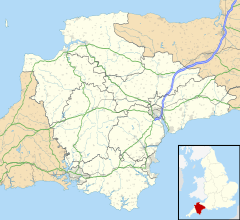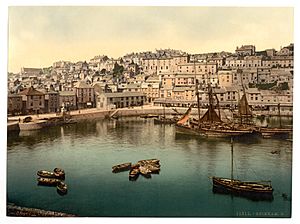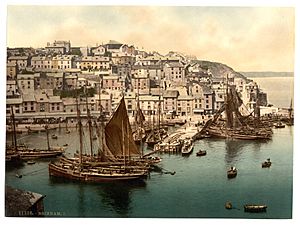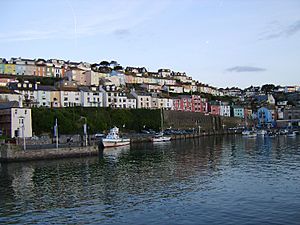Brixham facts for kids
Quick facts for kids Brixham |
|
|---|---|
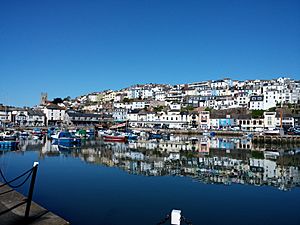 Brixham Harbour |
|
| Population | 16,693 (2011) |
| OS grid reference | SX9255 |
| Civil parish |
|
| Unitary authority | |
| Ceremonial county | |
| Region | |
| Country | England |
| Sovereign state | United Kingdom |
| Post town | BRIXHAM |
| Postcode district | TQ5 |
| Dialling code | 01803 |
| Police | Devon and Cornwall |
| Fire | Devon and Somerset |
| Ambulance | South Western |
| EU Parliament | South West England |
| UK Parliament |
|
Brixham is a fishing town and civil parish in the district of Torbay in the county of Devon, in the south-west of England. Brixham is at the southern end of Torbay, across the bay (Tor Bay) from Torquay, and fishing and tourism are the major industries of the town. At the time of the 2011 census it had a population of 16,693.
It is thought that the name 'Brixham' came from Brioc's village. 'Brioc' was an old English or Brythonic personal name and '-ham' is an ancient term for home derived from Old English.
The town is hilly and built around the harbour which remains in use as a dock for fishing trawlers. It has a focal tourist attraction in the replica of Sir Francis Drake's ship Golden Hind that is permanently moored there.
Historically, Brixham was two separate communities with only a marshy lane to connect them. Cowtown was the area on top of the hill where the farmers lived, while a mile away around the harbour was Fishtown where the fishermen and seamen lived. Cowtown, the St Mary's Square area, is on the road leaving Brixham to the south west, in the direction of Kingswear, upon which stands a church built on the site of a Saxon original. The town holds a yearly pirate event which competes for the title of most pirates in one place and this draws visitors from far and wide.
King William III landed in England at Brixham on 5 November 1688 on his way to become king as part of the Glorious Revolution.
Contents
History
Although there is evidence of Ice age inhabitants here, and probable trading in the Bronze Age, the first evidence of a town comes from the Saxon times. It is possible that Saxon settlement originated by sea from Hampshire in the 6th century, or overland around the year 800.
Brixham was called Briseham in the Domesday Book. Its population then was 39.
Brixham was part of the former Haytor Hundred. The population was 3,671 in 1801 and 8,092 in 1901. In 1334, the town's value was assessed at one pound, twelve shillings and eightpence; by 1524, the valuation had risen to £24 and sixteen shillings. It is recorded as a borough from 1536, and a market is recorded from 1822. William de Whithurst, a distinguished Crown official and judge in Ireland, became parish priest of Brixham in 1350.
William Prince of Orange (afterwards King William III of Great Britain & Ireland) landed in Brixham, with his mainly Dutch army, on 5 November 1688 during the Glorious Revolution, and issued his famous declaration "The Liberties of England and The Protestant Religion I Will Maintain". A road leading from the harbour up a steep hill, to where the Dutch made their camp, is still called Overgang, Dutch for 'passage' or 'crossing'.
The coffin house reflects Brixham humour: it is coffin-shaped and when a father was asked for the hand in marriage of his daughter, he said he would 'see her in a coffin, before she wed'. The future son-in-law bought the coffin-shaped property, called it the Coffin House, and went back to the father and said 'Your wishes will be met, you will see your daughter in a coffin, the Coffin House'. Amazed by this, the father gave his blessing.
The street names reflect the town's history. Pump Street is where the village pump stood. Monksbridge was a bridge built by the monks of Totnes Priory. Lichfield Drive was the route that the dead (from the Old English 'lich' meaning a corpse) were taken for burial at St Mary’s churchyard. Salutation Mews, near the church, dates from when England was Catholic, and the salutation was to the Virgin Mary. Similarly, Laywell Road recalls Our Lady’s Well. The first building seen when coming into Brixham from Paignton is the old white-boarded Toll House where all travellers had to pay a fee to keep the roads repaired.
The tower of All Saints' Church, founded in 1815, stands guard over the town. The composer of Abide With Me, Rev. Francis Lyte was a vicar at the church. He lived at Berry Head House, now a hotel, and when he was a very sick man, near to dying, he looked out from his garden as dusk fell over Torbay, and the words of that hymn came into his mind.
The main church is St. Mary's, about a mile from the sea. It is the third to have been on the site (which was an ancient Celtic burial ground). The original wooden Saxon church was replaced by a stone Norman church that was, in its turn, built over in about 1360. Many of the important townspeople are buried in the churchyard.
Many of Brixham's photogenic cottages above the harbour were originally inhabited by fishermen and their families. Near the harbour is the famous Coffin House mentioned earlier. Many of the dwellings towards Higher Brixham were built largely between the 1930s to 1970s. Several holiday camps were built in this area, for example Pontin's Wall Park and Dolphin. The Dolphin was one of the company's biggest camps. The camp closed in 1991 after fire destroyed the main entertainments building.
Brixham was served by the short Torbay and Brixham Railway from Churston. The line, opened in February 1868 to carry passengers and goods (mainly fish), was closed in May 1963 as a result of the Beeching Axe cuts. Although the former line to Brixham is deserted and overgrown, the branch line through nearby Churston is now maintained and operated as a heritage railway by a team of volunteers as the Paignton and Dartmouth Steam Railway.
The British Seaman’s Boys' Home was founded in 1863 by William Gibbs of Tyntesfield for the orphan sons of deceased British seamen. It was closed in 1988 after 125 years.
On 28 April 1967 a flying saucer reportedly hovered for 80 minutes over Brixham at an altitude of 15,000 feet.
Maritime
Brixham is also notable for being the town where the fishing trawler was improved in the 19th century; the distinctive red sails of the Brixham trawlers were coated with the local red ochre for protection.
In the Middle Ages, Brixham was the largest fishing port in the south west of England. Known as the 'Mother of Deep-Sea Fisheries', its boats helped to establish the fishing industries of Hull, Grimsby and Lowestoft. In the 1890s, there were about 300 trawling vessels in Brixham, most individually owned. The trawlers can still be seen coming in and out of the harbour, followed by flocks of seagulls. The fish market is open to the public on two special days in the summer, when the finer points of catching and cooking fish are explained. The modern boats are diesel-driven, but several of the old sailing trawlers have been preserved.
Hundreds of ships have been wrecked on the rocks around the town. Brixham men have always known the dangers but even they were taken by surprise by a terrible storm that blew up on the night of 10 January 1866. The fishing boats only had sails then and could not get back into harbour because gale-force winds and the high waves were against them. To make things worse, the beacon on the breakwater was swept away, and in the black darkness they could not determine their position. According to local legend, their wives brought everything they could carry, including furniture and bedding, to make a big bonfire on the quayside to guide their men home. Fifty vessels were wrecked and more than one hundred lives were lost in the storm; when dawn broke the wreckage stretched for nearly three miles up the coast.
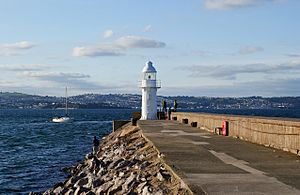
Hearing of this tragedy, the citizens of Exeter gave money to set up what became the Royal National Lifeboat Institution's Brixham Lifeboat in 1866. Now known as Torbay Lifeboat Station, it operates a Severn-class all-weather lifeboat and a D-class (IB1) inshore lifeboat. The crews have a history of bravery, with 52 awards for gallantry. The boathouse can be visited and memorials to the brave deeds seen; on special occasions visitors can go on board the boat. Two maroons (bangs) are the signal for the lifeboat to be launched.
Smuggling was more profitable than fishing, but if the men were caught, they were hanged. There are many legends about the local gangs and how they evaded the Revenue men. One humorous poem describes how a notorious local character, Bob Elliott ("Resurrection Bob"), could not run away because he had gout and hid in a coffin. Another villain was caught in possession but evaded capture by pretending to be the Devil, rising out of the morning mists. On another occasion when there was a cholera epidemic, some Brixham smugglers drove their cargo up from the beach in a hearse, accompanied by a bevy of supposed mourners following the cortege drawn by horses with muffled hooves.
The town's outer harbour is protected by a long breakwater, useful for sea angling. In winter this is a site for purple sandpiper birds.
To the south of Brixham, and sheltering the southern side of its harbour, lies the coastal headland of Berry Head with a lighthouse, Iron Age fort and national nature reserve.
Military

Warships have been seen in Torbay from the days of the Vikings up until 1944 when part of the D-Day fleet sailed from here. In 1588 Brixham watched Sir Francis Drake attacking the Spanish Armada after he had (so the legend goes) finished his game of bowls on Plymouth Hoe. Today in Brixham harbour there is a full-sized replica of the ship, the Golden Hind, in which Drake circumnavigated the globe; visitors can go on board.
For centuries, ships going down the English Channel have come into Torbay to seek refuge from the storms and to replenish food supplies. Sometimes these were merchants, taking cargoes to far away places and bringing back exotic goods and rare spices; sometimes they were carrying pilgrims, or gentlemen on the Grand Tour.
Since the days of Henry VIII Brixham has played a part in the defence of the nation. The headland known as Berry Head is now a national nature reserve, but it is also a military site where guns were once positioned to defend the naval ships that were re-victualling at Brixham. Twelve guns were put there during the War of American Independence, but were removed when peace came in 1783. Just ten years later, during a war with France, guns were again deployed around the town. The major position was at Berry Head, but this time fortifications were built to defend the gun positions. These can still be seen, and are now some of the best preserved Napoleonic forts in the country.
During the long series of wars against the French that began in 1689 and lasted until 1815, the Royal Navy came into Brixham to get supplies of fresh vegetables, beef and water. There might have been twenty or so of the big men-o'-war lying at anchor in Torbay, recovering from exploits of the sort described in the books about Hornblower, Bolitho or Jack Aubrey. On the harbourside towards the marina there is a grey stone building which today is the Coastguard headquarters; then, it was the King's Quay where His Majesty's vessels were provisioned. Local farmers brought vegetables to ward off scurvy, and cattle were slaughtered and their meat packed into barrels. The water came from a big reservoir situated near the crossroads in the middle of town; from there a pipeline carried it under the streets and under the harbour to the King's Quay.
Many of the well-known admirals of the day visited Brixham. Not only Nelson, but also Lord St. Vincent, Cornwallis, Hood, Rodney and Hawke. There was also Earl Howe, who earned the nickname of Lord Torbay because he spent so much time ashore in Brixham. A notorious visitor was Napoleon Bonaparte, who, as a prisoner on HMS Bellerophon, spent several days off Brixham waiting to be taken to exile on St. Helena.
Battery Gardens have a military history leading back to the Napoleonic wars and the time of the Spanish Armada. The emplacements and features seen here today are those of the Second World War and are of national importance. The site, listed by English Heritage, is recognised as one of the best preserved of its kind in the UK. Of the 116 'Emergency Coastal Defence Batteries' set up in the UK in 1940, only seven remain intact.
During the Second World War, a ramp and piers were built on the breakwater, from which American servicemen left for the D-day landings.
The 1969 Fleet Review was held in Torbay, to present new Sovereign's Colours to the Royal Navy. When the Fleet was lit up at night "The Bay gave the impression that it had been filled with a completely new town: an amazing sight!"
Noted military historian & folk musician Chester Giles was a previous resident of Brixham.
Industrial
Apart from fishing, most of the other local industries were connected with stone. Limestone was once quarried and used to build the breakwater, for houses and roads, and was sent to Dagenham to make steel for Ford automobiles. It was also burnt in limekilns to reduce it to a powder which was spread on the land in other parts of Devon as an agricultural fertiliser. The old quarries and the limekilns can still be seen.
Another mineral found in Brixham is ochre. This gave the old fishing boats their "Red Sails in the Sunset", but the purpose was to protect the canvas from sea water. It was boiled in great caldrons, together with tar, tallow and oak bark. The latter ingredient gave its name to the barking yards which were places where the hot mixture was painted on to the sails, which were then hung up to dry. The ochre was also used to make a paint. This was invented in Brixham in about 1845 and was the first substance in the world that would stop cast iron from rusting. Other types of paint were made here as well, and the works were in existence until 1961.
There were iron mines at Brixham, and for a while they produced high quality ore but the last one closed in 1925. Most of the sites have been built over and there are now no remains of this once important industry.
Festivals and events
Brixham plays host to a number of festivals and events throughout the calendar year. These events are run entirely by locals and contribute significantly to the local economy.
BrixFest
BrixFest is a relatively new, annual family friendly festival in Brixham. In 2015 it will run over the Whitsun Bank Holiday. The festival took over from the now defunct Brixham Heritage Festival in 2010 and has recently established itself as one of Brixham's core annual events.
Brixham Pirate Festival
The Brixham Pirate Festival, more formally called 'The International Brixham Pirate Festival', is known for its world record attempts, live music, free entertainment and for filling Brixham with pirates. It is an annual event which takes place over the Mayday Bank Holiday.
Brixham Hap'nin
The Brixham Hap'nin, also known locally as 'Party in the Park', is an annual live music and arts festival in Brixham. It is generally a two-day festival operating out of St Mary's Park in the Cowtown part of Brixham, with live music, performances from local schools, food and drink market stalls and concessions, dance acts and amateur dramatics.
RNLI Lifeboat Week
Torbay has been served by Lifeboats since 1866 and Brixham has provided the base for a lifeboat since then. The station was granted the Freedom of the Borough of Torbay in 1988. Torbay Lifeboat Station is based close to the Breakwater, and this becomes the centre of a series of events planned by the local volunteers and sponsors. Events include the ‘Walk the Extra Mile’ for the Lifeboat crew and the prize draw, guided tours of the All Weather Lifeboat, ‘Brixham has Talent’, with local school bands on the XRadio One Stage, and an evening ticket only event ‘Bands on the Beach’.
Fishstock
Fishstock is a one-day, annual seafood and live music festival held inside the new Fish Market Development on the harbour side.
Transport
Brixham railway station was the terminus of the Torbay and Brixham Railway. It served the town from the bay platform at Churston station until the line was closed in 1963. Some of the track bed remains in place. Houses in Harbour View Close were built on the site of the station. The Association of Train Operating Companies included Brixham as one of fourteen towns that, based on 2009 data, would benefit from a new railway service, but restoration is highly unlikely.
Although Brixham is no longer on the rail network, frequent buses taking 25 minutes connect Brixham with the national rail network at Paignton, where the bus station is conveniently situated opposite the rail station. Trains from Paignton run to destinations such as Exeter Central, Exmouth, London Paddington and Birmingham New Street.
Torbay's flagship bus route, Stagecoach South West service 12, operates up to every 10 minutes and has its terminus at Brixham Town Square, with the service returning to Newton Abbot via Paignton, Torquay and Kingskerswell. The service also calls at the Brixham Park and Ride site located on the A3022 (Dartmouth Road). Flat rate parking charges include a bus ride for a car's occupants to Brixham and return.
Stagecoach service 18 take about 15 minutes for the journey from Brixham (Bank Street) to Kingswear, where a river crossing to Dartmouth can be made by ferry.
Local town services operated by both Stagecoach and Country Bus, serve Furzeham, Wall Park, Sharkham, South Bay, Higher Brixham, Summercombe and Hillhead.
There are direct National Express coach services to London via Bristol and Heathrow Airport, and Sheffield via Bristol and Birmingham.
Frequent ferry services for foot passengers operate from Brixham Harbour to Torquay between the months of April and September, the fastest taking 35 minutes. There are also seasonal ferries to Paignton. Pleasure cruises also call at Brixham Harbour en route from Torquay to Dartmouth, during the spring, summer and autumn.
Brixham Caverns
- Brixham Cavern
- Brixham Cave, called also Windmill Hill Cavern
- Ash Hole Cavern
- Kents Cavern
- English Riviera Geopark
- Discovery of human antiquity
- Hugh Falconer
- William Pengelly
- Discovery of human antiquity: Acceptance of human association with extinct animal species
- 'Empirical Evidence for the Antiquity of Mankind at Brixham Cave' - Claude Nelson Warren - 1998
- The Antiquity of Man by Sir Charles Lyell
Sport
Brixham is home to the Brixham Archers. This is the biggest archery club in the bay and shoots outdoors at their field at Churston. Brixham Archers also use an indoor facility in Brixham. The Archery club was formed in 1969 and has been successful at county and national level competitions.
In 1874, Brixham Rugby Club was founded and became one of the founder members of Devon RFU of which six clubs are now left. They played Rugby on Furzeham Green until 1896 when they moved their present ground to New Gate Park (now Astley Park). The club will play their league fixtures in the National League 3 South West division of English rugby.
Footballer Dan Gosling, of Bournemouth F.C., was born and raised in Brixham, and is the fourth-youngest player to have ever played for Plymouth Argyle aged 16 years and 310 days.
Brixham is also home to Brixham AFC who were founded in 2012, following the merger of Brixham United and Brixham Villa football clubs. The club play their home matches at Wall Park Ground and currently play in the South West Peninsula League Premier Division East.
Education
Brixham has a number of schools, mostly located in the centre of residential areas.
The town has one secondary school, Brixham College.
Other schools and academies in Brixham and the surrounding area include
- Eden Park Primary School Academy
- Brixham Church of England Primary School
- Saint Margaret Clitherow Catholic Primary School
- Furzeham Primary School
See also
 In Spanish: Brixham para niños
In Spanish: Brixham para niños


